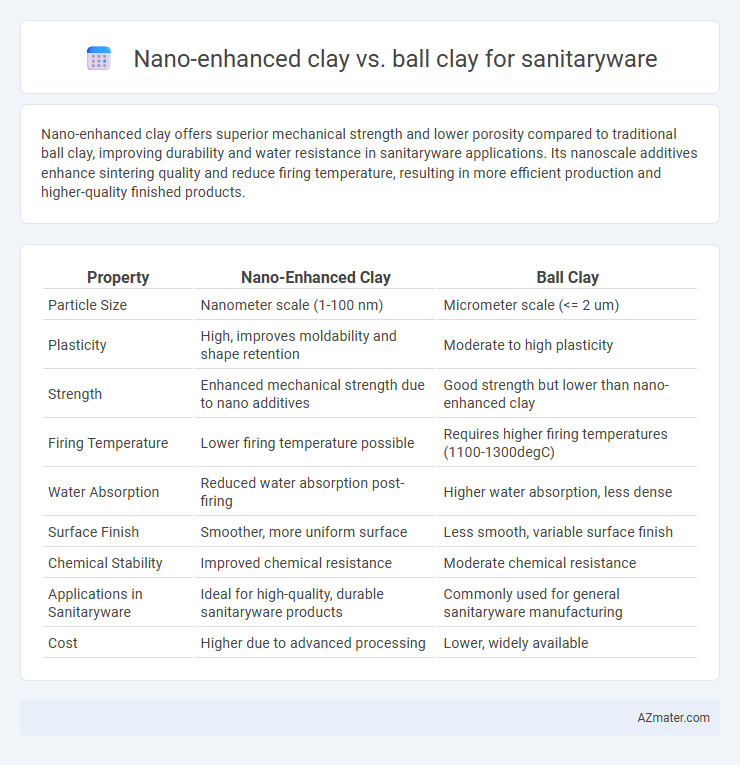Nano-enhanced clay offers superior mechanical strength and lower porosity compared to traditional ball clay, improving durability and water resistance in sanitaryware applications. Its nanoscale additives enhance sintering quality and reduce firing temperature, resulting in more efficient production and higher-quality finished products.
Table of Comparison
| Property | Nano-Enhanced Clay | Ball Clay |
|---|---|---|
| Particle Size | Nanometer scale (1-100 nm) | Micrometer scale (<= 2 um) |
| Plasticity | High, improves moldability and shape retention | Moderate to high plasticity |
| Strength | Enhanced mechanical strength due to nano additives | Good strength but lower than nano-enhanced clay |
| Firing Temperature | Lower firing temperature possible | Requires higher firing temperatures (1100-1300degC) |
| Water Absorption | Reduced water absorption post-firing | Higher water absorption, less dense |
| Surface Finish | Smoother, more uniform surface | Less smooth, variable surface finish |
| Chemical Stability | Improved chemical resistance | Moderate chemical resistance |
| Applications in Sanitaryware | Ideal for high-quality, durable sanitaryware products | Commonly used for general sanitaryware manufacturing |
| Cost | Higher due to advanced processing | Lower, widely available |
Introduction to Sanitaryware Material Choices
Nano-enhanced clay offers superior mechanical strength and reduced porosity compared to traditional ball clay, making it an innovative choice in sanitaryware manufacturing. Ball clay, known for its plasticity and workability, remains popular but lacks the nanoscale reinforcement that enhances durability and surface smoothness in finished products. Selecting between nano-enhanced clay and ball clay significantly impacts the performance, longevity, and aesthetic quality of sanitaryware fixtures.
Overview of Ball Clay in Sanitaryware Production
Ball clay, characterized by its high plasticity, fine particle size, and excellent binding properties, is a key raw material in sanitaryware production, contributing to shaping and mechanical strength. Its smooth texture allows for improved moldability and surface finish, essential for the intricate designs and durability of sanitaryware products. Compared to nano-enhanced clay, ball clay remains favored for its proven performance in achieving the required balance of workability and fired strength in sanitaryware manufacturing.
Emergence of Nano-Enhanced Clay Technologies
Nano-enhanced clay technologies have revolutionized the sanitaryware industry by significantly improving mechanical strength, durability, and surface smoothness compared to traditional ball clay. The incorporation of nanoparticles into clay matrices enhances particle packing density and reduces porosity, resulting in superior glaze adherence and resistance to cracking. These advancements lead to more efficient manufacturing processes and higher-quality sanitaryware products with extended service life.
Mechanical Strength: Nano-Enhanced vs Ball Clay
Nano-enhanced clay significantly improves mechanical strength in sanitaryware by increasing particle bonding and reducing porosity compared to traditional ball clay. Its nanoscale additives enhance the material's flexural strength and fracture toughness, resulting in more durable and impact-resistant sanitary products. Ball clay, while offering good plasticity and workability, generally provides lower tensile and compressive strength than nano-enhanced clay formulations.
Water Absorption and Porosity Comparison
Nano-enhanced clay exhibits significantly lower water absorption rates compared to conventional ball clay, making it highly suitable for sanitaryware applications that demand superior moisture resistance. The incorporation of nanoparticles refines the microstructure, reducing the overall porosity and enhancing the mechanical strength of the ceramic body. Ball clay, while valued for its plasticity and workability, typically demonstrates higher porosity and water absorption, which can compromise the durability and hygiene of sanitaryware products.
Surface Finish and Aesthetic Differences
Nano-enhanced clay provides a significantly smoother surface finish compared to traditional ball clay, resulting in fewer surface defects and enhanced glaze adhesion in sanitaryware production. The addition of nanoparticles refines the microstructure, producing a more uniform and glossy aesthetic, which is highly desirable in high-end ceramic sanitaryware. Conversely, ball clay offers good plasticity and workability but often requires additional processing to achieve the same level of surface refinement and visual appeal as nano-enhanced alternatives.
Thermal Resistance and Firing Behavior
Nano-enhanced clay exhibits superior thermal resistance compared to traditional ball clay, enabling higher temperature tolerance during sanitaryware production. The incorporation of nanoparticles improves the firing behavior by promoting uniform sintering and reducing shrinkage, resulting in enhanced mechanical strength and surface smoothness. Ball clay, while known for plasticity and workability, typically requires longer firing cycles and exhibits lower thermal stability, making nano-enhanced clay a more efficient choice for advanced sanitaryware applications.
Environmental Impact and Sustainability
Nano-enhanced clay offers significant environmental benefits over traditional ball clay in sanitaryware production due to its lower raw material extraction rates and reduced energy consumption during processing. The enhanced mechanical properties of nano-enhanced clay allow for thinner, lighter sanitaryware, decreasing the carbon footprint associated with transportation and material usage. Sustainable manufacturing is further supported by the potential for recycling and decreased water usage in nano-clay processing compared to conventional ball clay methods.
Cost Analysis and Manufacturing Considerations
Nano-enhanced clay offers improved mechanical strength and reduced firing temperatures compared to traditional ball clay, leading to lower overall energy costs in sanitaryware production. Although the initial material cost of nano-enhanced clay is higher, its enhanced properties reduce wear on molds and equipment, minimizing maintenance expenses. Manufacturing considerations for nano-enhanced clay include the need for updated processing techniques and potential investment in new machinery to optimize performance, whereas ball clay provides consistent workability and established processing methods with lower upfront costs.
Future Trends in Sanitaryware Material Innovation
Nano-enhanced clay offers superior mechanical strength, improved water absorption, and enhanced thermal stability compared to traditional ball clay, positioning it as a key material for future sanitaryware innovations. The incorporation of nanomaterials optimizes surface smoothness and durability, meeting increasing industry demands for eco-friendly and high-performance sanitary fixtures. Ongoing research emphasizes sustainable synthesis methods and multifunctional properties, driving the transition from conventional ball clay towards advanced nano-enhanced composites in sanitaryware manufacturing.

Infographic: Nano-enhanced clay vs Ball clay for Sanitaryware
 azmater.com
azmater.com